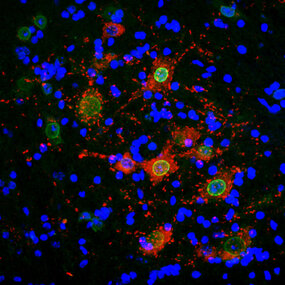Work of Salim Megat, a team member, has led to a better understanding of the genetic structure of ALS, which findings have just been published in Nature Communications.
The study shows that new genetic risk factors for ALS are present in certain parts of the genome that are important for specific proteins, notably TDP-43 and FUS. While these proteins accumulate abnormally in the brain of patients. Beyond this analysis, several new genes associated with ALS have been identified.
Thanks to numerous national (Institut du Cerveau, Paris; CHU de Limoges, Institut Imagine) and international (DZNE Ulm, Germany; Donders Institute, Nijmegen, Netherlands) collaborations, the team was able to show that the loss of function of one of these genes, NUP50, was associated with ALS.
NUP50 is a nuclear pore protein, which allows the trafficking of proteins between the cell nucleus and the cytoplasm. Its loss in ALS could explain the significant nuclear pore abnormalities already observed in many other studies.
As a whole, this study establishes several novel direct links between the genetics and pathophysiology of ALS.
Source : Megat S., et al. Integrative genetic analysis illuminates ALS heritability and identifies risk genes. Nat Commun 14, 342 (2023). https://doi.org/10.1038/s41467-022-35724-1
Contact: Luc Dupuis,
Credits: Helene Cheung-Bouaoun


